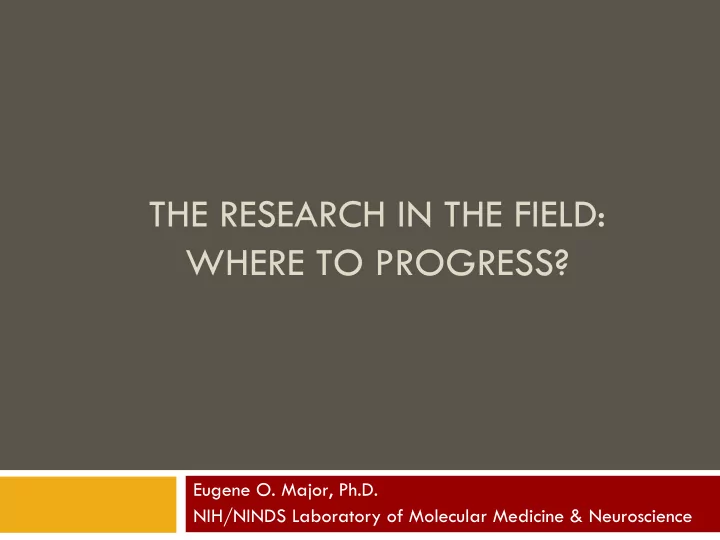

THE RESEARCH IN THE FIELD: WHERE TO PROGRESS? Eugene O. Major, Ph.D. NIH/NINDS Laboratory of Molecular Medicine & Neuroscience
Major Research Areas 2 Disease incidence How do we define it? Who gets it? Virus that causes PML Geographic distribution of the virus Host range factor Patients with the PML Affected patient populations Use of genomics Clinical correlates
Disease Incidence 3 Better understanding of pathogenesis (translational approach) Consensus on diagnostic criteria American Academy of Neurology PML guidelines More information on other non-PML diseases associated with JC virus
Virus that causes PML 4 Geographic distribution of the virus (type) and correlation for disease (Is PML in India the same as PML in Europe/North America?) Host range factor determined by the receptor and gene sequences (cellular tropism)
Tools for Translational Opportunities 5 To advance PML research, the community needs a better way to assess information from these correlating factors using an open source. Currently, two data registries are being developed to accomplish this task. NINDS: Laboratory of Molecular Medicine and Neuroscience has convened a steering committee of clinicians and investigators representing patient populations at risk for PML (rheumatology, neurology, epidemiology, transplantation, virology, and oncology) to develop standard diagnostic criteria and other data elements PML Consortium: Representatives from pharmaceutical/biotechnology companies who have come together to coordinate resources to further PML research
NINDS PML Data Registry 6 Mock data was used to produce this graphic. Actual data will flow from the registry to populate this dashboard in real-time.
Tools for Translational Opportunities 7 To advance PML research, the community needs a better way to assess information from these correlating factors using an open source. Currently, two data registries are being developed to accomplish this task. NINDS: Laboratory of Molecular Medicine and Neuroscience has convened a steering committee of clinicians and investigators representing patient populations at risk for PML (rheumatology, neurology, epidemiology, transplantation, virology, and oncology) to develop standard diagnostic criteria and other data elements PML Consortium: Representatives from pharmaceutical/biotechnology companies who have come together to coordinate resources to further PML research
Fig. 4. Overview of an HIV Latency Collaboratory representing a joint research venture between the U.S. National Institutes of Health (NIH), the pharmaceutical industry (pharma), and academia. D D Richman et al. Science 2009;323:1304-1307 Published by AAAS
What don’t we know… 9 Transmission: vertical/horizontal; some data on maternal transmission Initial site(s) of infection; respiratory, ingestion; cellular site for multiplication and spread Genotype(s) of ‘circulating’ virus; assumed ‘archetype’ Cell factors for tropsim Establishment of latency (episome or integrated DNA), mechanism of release from latency Traffic of virus to brain; cross blood:brain:barrier Role of humoral immunity Predictive markers for PML; clinical, virological, immune Early stages of PML; progressive/persistent PML Treatment; boost immune response, block viral growth
10
Recommend
More recommend